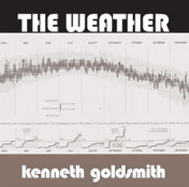THE WEATHER
BY KENNETH GOLDSMITH. LOS ANGELES: MAKE NOW PRESS. 120 PAGES. $14.
Stacey Levine
(Bookforum, Feb/Mar 2006)

There is a quality of boyish industry and verve in Kenneth Goldsmith's poetic experiments. A documentarian and visual artist, Goldsmith employs only one constraint in his new book: There is no writing from the author. Instead, he typed all content in The Weather verbatim from a New York City radio station's weather forecasts. These predictions are formed into narrative-style paragraphs, which are in turn divided into four sections, each representing a season of the year.
This is probably not a text many will read straight through, yet the point of the book is less its meaning than the decision to assemble it. And in fact there are many angles and comforts to this experiment. Goldsmith's text is both a literal description of a year of New York days and a baffling, blank, skylike wash in which readers will sense what they will. The weather, as constant as night and day or the daily rhythms of human life, courses along in this impervious manner for 120 pages: "And, what we have here is, uh, very humid conditions for the nighttime hours, uh, temperatures only dipping back into the mid-sixties. Uh, it has been, uh, quiet on the radar, uh, we did have quite a bit of rain north of the city all day long, and the rain is now starting to show up, uh, to our southwest, this is getting into the, uh, Harrisburg, Lancaster area."
Though transcribed from reports in 2002 and 2003, the weather forecasts in this book carry a nostalgic tang, with their intermittent "uhs" and "ers" from the unidentified radio announcer; in fact, it's almost surprising to be reminded that, though live television is now a rarity, radio continues to be just such a medium. Like other works by Goldsmith (Fidget, for example, records the movements of the author's body over an eleven-hour span), this text is an idiosyncratic record of time, one that searches for ways of cataloguing moments precisely. By tracking radio weather, as opposed to larger world events, Goldsmith seems to offer the reader an opportunity to capture the full spectrum of lived experience in a satisfying way.
In lesser hands, this kind of textual experiment might seem clumsy or ironic. But Goldsmith's patience—his ear is bent toward the mundane—and his light framing of the material allow The Weather to become kaleidoscopic, full of clouds, a subtle paean to the living world and its constancy. This, alongside the interspersed "battlefield" forecasts from Iraq, offers a simple rendering of what we already know: that there is anxiety in the midst of wind and gorgeousness.
Back to Kenneth Goldsmith's Author Page | Back to EPC
|
